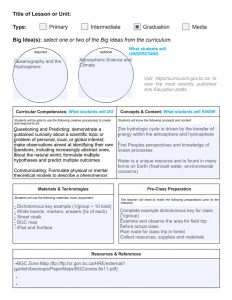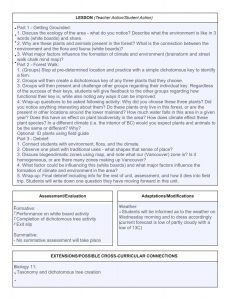This lesson serves as an introduction to our unit. The main focus of this lesson revolves around grounding students in their environment by going on a nature walk in Pacific Spirit Park. Students are encouraged to immerse themselves in the forest, and also inquire about the role of weather on shaping the structure of the forest.
(Note: Lesson is subject to change)
Pletsch_J.Maclean_S.Pace_EDCP_455_Lesson Plan



We thought your lesson was very interactive and filled with connection to local and global issues. The walk in the woods was great and the assessment was creative as it allowed students to evaluate their peers’ abilities to construct and also use a dichotomous key.
Cheers,
Julia,Laura and Kristen
Also…
There were enough activities to keep everyone engaged and avoid any class management issues. The lesson plan addressed multiple learning types, and the hike was easy so anyone (even someone with physical disabilities) could access the trail.44
Dear Steve, Shaun, and Jim,
We liked that you used the mind map as the introduction and conclusion for the mini-field trip to Pacific Spirit Park. By having the mind map as an introduction, it probed our prior knowledge about the interconnectivity of the region we live in. Using the mindmap as a conclusion was beneficial because it allowed us to reflect on the gaps that existed in the mindmap before our adventure.
We also particularly enjoyed the activity! Making up fake names and testing the quality of our dichotomous key by challenging other groups to use them.
Regarding a wish, we would be interested to see how this activity would work during a 70 minute class period or if it would need to be a morning/afternoon trip. Written instructions would have also been beneficial to keep organized and to re-focus after outside distractions (ie. dogs).
Overall, we thought this was an engaging lesson and appreciate your planning!
Best regards,
Jordan & Dragana
Stars: Mind map to probe for previous knowledge; however, still came back to it in the end of the lesson to bring it together and add any knowledge that was gained throughout the lesson.
Lesson was cross curricular and brought in knowledge from other subject areas such as biology, earth science, first nations perspectives, etc.
Tied lesson into local environment as well as global scale.
Wishes: Lesson was a little long – have to be modified for time constraints. Also contained a lot of content in a small amount of time, can be improved by doing this lesson over multiple classes.
Bringing in more earth science knowledge can be helpful – less on identification of plants and more on abiotic factors that influence their distribution.
Hey you guys – the attached lesson plan (pdf) is not filled out – there is no text. Or am I missing something? I can comment on the lesson but would love to see the written component. Thanks!!
Hi Sarah – try clearing your cache or zooming in on the images to look at the lesson plan. If either of those don’t work let me know and I can email or Facebook the lesson plan to you!
Your lesson was great! Really enjoyed starting the day outside! We really loved the sidewalk chalkboard mind-map and that we revisited it before the end of the lesson. The activities in the forest were great and very engaging. You kept us busy the whole time which prevents kids from getting off task. A couple of suggestions: when you do the dichotomous key have the groups exchange keys and then try and find the plant they were trying to describe. Also, we thought there might have been too much information in this particular lesson for kids to digest. Perhaps this could be reduced or spread out over two different walks. Last thing, the unit is about oceanography and we only heard the word “oceanography” and the connection to the unit near the very end of the lesson. BUT it was awesome and so good to get outside!
Great job, Steve, Jim & Shaun! Your lesson at the Pacific Spirit Park was very interactive and engaging! Using a mind map was a great way to start your lesson to get us to think about the topic and for you to assess our prior knowledge. Also, going back to the mind map at the end of the lesson tied in all the conceptual knowledge and newly learned knowledge together. We also appreciated the integration of Indigenous people’s traditional ecological knowledge and their ways of knowing in your lesson. It was really great to be outside and learn through experiential learning – so much better than sitting in the classroom for 70 minutes! However, it did feel like you were trying to do a lot in one lesson – this can cause cognitive overload for many students. It would be nice to break down this lesson into chunks (over multiple days) for students to digest the materials better. Also, we would’ve liked more information on oceanography… 🙂
All in all, great lesson! Thanks!
Unit Plan Feedback:
Stars: Considered First People’s perspectives of learning in planning the lessons. Provided multiple means of formative assessment. Lots of scaffolding provided for students.
Wishes: Incorporate ELL and IEP support. Discussion of support for people who can’t pay for Bamfield field trip.
Lesson Feedback:
Stars: Loved the idea of place-based teaching in a local forest/trail and the incorporation of multi-sensory learning, which made the lesson very engaging. The sidewalk chalk art (cross-curricular incorporation) before and after the lesson really helped to tie together our understanding.
Wishes:
Probing for background knowledge of the biosphere/hydrologic cycle before the lesson, so that students who are not familiar with these concepts do not feel lost during the discussions.